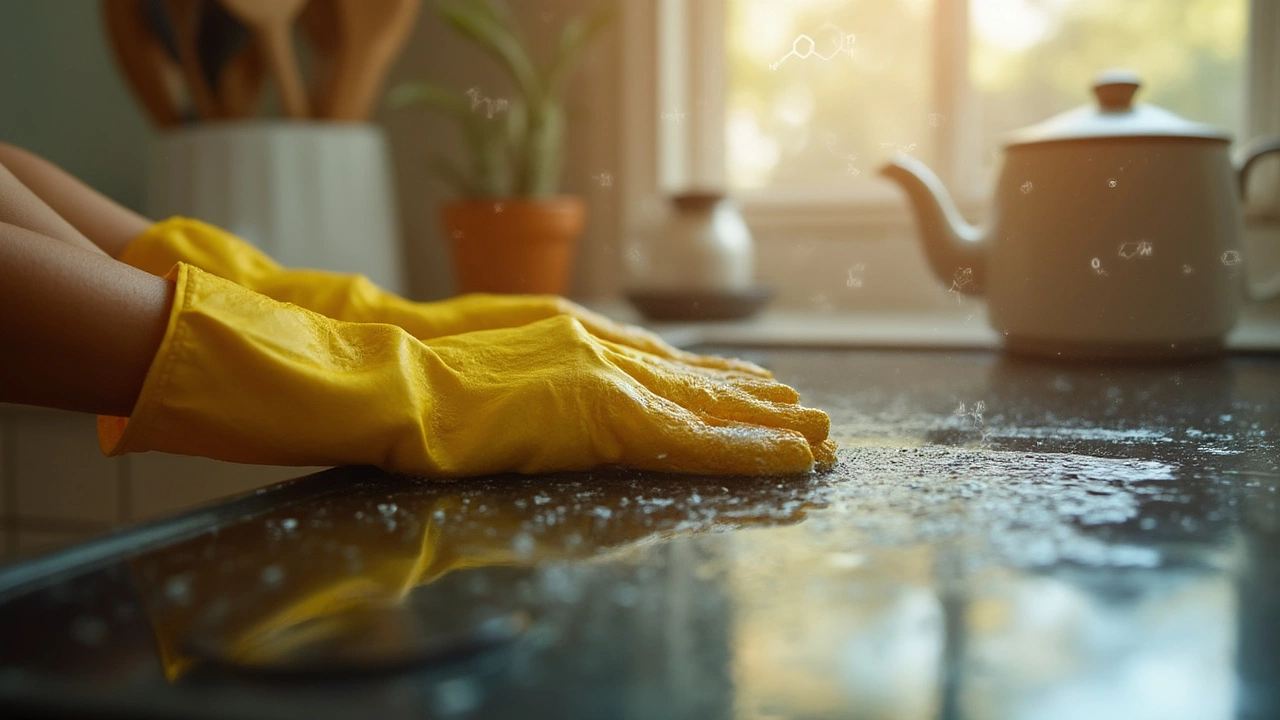If you’ve ever opened your oven door and been greeted by a crusty, burnt patch of grease, you know the pain. No one gets excited about tackling that sticky mess, but ignoring it turns your kitchen into a greasy horror show. Baked-on grease doesn’t just look rough—it can actually make future meals taste off, mess up heat distribution, and even create a fire risk. There’s no magic wand, but there are smart choices that make life a lot easier. The real question is: what actually works, and what’s a waste of elbow grease? Let's get into the practical details so you can win this one.
The Science Behind Baked-On Grease
Baked-on grease is stubborn for a reason. When you roast, fry, or broil, little splatters of oil and food bits hit hot surfaces and go through chemical reactions. The fats break down and, together with proteins and sugars from food, create what’s basically a kitchen superglue called polymerized grease. Once it cools and sets, it’s way tougher than a simple oil spill on the counter. Think of it like re-cooled caramel stuck to a pot—easy to pour, but a nightmare when it hardens.
Not all cleaners are designed to tackle this chemistry experiment. If you just grab standard all-purpose spray, you may make a dent, but you’ll probably just smear things around. You need something to break the chemical bonds. Degreasers with alkaline ingredients are the MVPs here. Sodium hydroxide (lye), sodium carbonate (washing soda), and even baking soda (a gentler alkaline) loosen up the molecular structure so you can wipe stuff away. The more built-up the mess, the tougher you need to go. But there’s a balance because harsh chemicals can damage your oven’s enamel, create fumes, or even corrode parts. Using the wrong stuff could void warranties or mess with protective coatings. The trick is finding a product or homemade mix that packs enough of a punch without turning your kitchen into a hazmat zone.
Here’s a quick look at just how different these products attack grease:
| Degreaser | Main Ingredient | Grease-Busting Power | Safe for Food Surfaces |
|---|---|---|---|
| Commercial Oven Cleaner | Sodium Hydroxide | High | Rinse Required |
| DIY Baking Soda Paste | Baking Soda | Medium | Yes |
| Vinegar Solutions | Acetic Acid | Low/Medium | Yes |
| Dish Soap & Hot Water | Sodium Laureth Sulfate | Low | Yes |
Top Commercial Cleaners: What Actually Works?
Walk through the supermarket cleaning aisle and the choices can be dizzying. But when it comes to baked-on grease, not all products are created equal. Some of the best-reviewed commercial cleaners in 2025 include Easy-Off Professional Fume Free Oven Cleaner, Zep Heavy-Duty Citrus Degreaser, and Goo Gone Kitchen Degreaser. These have been tested by actual home cooks and even professional cleaning crews, and the results speak for themselves.
Easy-Off is famous for a reason. This cleaner uses a powerful alkaline base, but the odorless “fume free” version cuts down on coughing and watery eyes. Just spray, let it work its magic for 30 minutes, and you’ll see gunk bubble up. Zep Heavy-Duty leans into citrus solvents which are derived from orange peels. While citrus oils are eco-friendly, they’re also real grease-cutters. Goo Gone is a nice balance, with enzymes and solvents—perfect for daily splatters and the weekly deep clean. They’re all food-surface safe as long as you rinse thoroughly after use.
One thing that’s changed recently: more brands are disclosing full ingredient lists, and several have earned “Safer Choice” or “Greenguard” seals, meaning lower risks for home use. If you’ve got pets or allergic family members, double-check labels and ventilate well, even with safer brands. Still, no product is fully hands-off. You’ll need a good sponge, maybe some gloves, and a bit of muscle. But using genuinely effective products means no endless scrubbing marathons.
Here’s an important trick: don’t rush the process. Most top cleaners work best when you let them sit—some up to an hour—so clear your schedule before starting. If the first application doesn’t budge the oldest spots, hit them again instead of attacking with steel wool (unless you like scratches and worn-out enamel). For glass oven doors, skip powders and use the foam version of your cleaner for an even coat and less chance of streaks.
Homemade Solutions: Cheap and Surprisingly Effective
You don’t have to empty your wallet to make real progress against baked-on grease. Baking soda and vinegar are kitchen legends for a reason. For basic jobs, a thick paste of baking soda and water, left on overnight, can soften up most messes. Want more oomph? Slosh on a little white vinegar over the dried-baking-soda paste. It will bubble like a volcano and help lift stubborn patches. After a few hours (or a whole night for bad cases), just use a damp cloth to wipe away the residue.
This isn’t just a folksy tip; labs at places like Consumer Reports have shown that baking soda is mildly abrasive and alkaline, so it can break down lightly-polymerized grease while being gentle on surfaces. Still, it won’t replace the power of commercial sodium hydroxide for years-old grime, but most people don’t need the heavy stuff as often as they’d expect.
You can boost the cleaning action by using hot water—grease softens around 40°C (104°F), so microwave a damp cloth or gently soak oven racks in your bathtub with a cup of baking soda dissolved in hot water. Old toothbrushes or even expired store cards make great scrubbers for tricky corners and grooves.
A few more DIY tips that actually work:
- Degrease while oven is slightly warm. Don’t attack fresh after cooking, but pre-warming to 50°C (122°F) helps cleaners penetrate.
- Add a drop of dish soap (like Dawn or Fairy Platinum) to your baking soda paste for extra clinging power.
- Try lemon juice as an alternative to vinegar if you hate the smell, though both are acidic and work similarly.
- Old stains? Cover them in the baking soda paste and lay a damp towel over the area. Moisture helps the chemical action keep working longer.
For people worried about safety or wanting to avoid harsh fumes, this route is golden. No mask needed, no skin-burning splashes—just a bit of patience and some clever mixing. Plus, you’ll save money and never run out of supplies in the middle of a cleaning session.

Tools Matter: Scrapers, Brushes, and Steam
People often focus so much on the cleaner that they forget about the tools. But the right scraper or brush can make the difference between struggling for hours and wrapping up in half the time. Nylon or silicone scrubbers are safe for most oven interiors and glass—these are the same materials found in modern dish brushes. If you need to get under a hardened bit, reach for a plastic razor blade scraper. They’re cheap, reusable, and far less risky than metal for scratching your precious oven glass or enamel.
For racks, nothing beats a good soak in hot soapy water. Pop the racks in your bathtub lined with a towel (to prevent scratching) and pour in a generous sprinkle of washing soda. Let them sit for a few hours, scrub with a brush, and rinse well. Don’t want to bother? Dishwasher detergent tablets dissolved in hot water mimic commercial soaking solutions.
Steam is the secret weapon if you want to skip harsh chemicals. An entry-level handheld steam cleaner creates a blast of hot vapor that loosens layers of congealed grease. Steam works at over 100°C (212°F), so it softens polymerized fats without wrecking paint or leaving residues. It also kills bacteria, which is nice if you’re a germaphobe. Just avoid blasting steam at digital panels or sensitive electrical parts.
Here’s a list of practical tools for tackling baked-on grease:
- Nylon/silicone non-scratch scrub pads
- Plastic razor blade scrapers
- Old toothbrushes (for nooks and crannies)
- Microfiber cloths (trap loosened grease better than sponges)
- Handheld steam cleaners (for a chemical-free boost)
- Rubber gloves (save your skin from dryness and irritation)
Invest once in a handheld steamer and you’ll use it for everything from stove grates to bathroom tiles. It’s oddly fun watching grime melt away—just keep plenty of towels around to mop up the goo that follows.
Prevention: Make Future Cleaning Way Easier
Believe it or not, the real “best cleaner” is the one you rarely have to use because you don’t let grease win in the first place. Prevention sounds boring, but it pays off big. Lining the bottom of your oven with a reusable non-stick oven liner (they go for about £10 online) catches drips before they harden into the floor. These sheets go in the dishwasher and last ages. For stovetops, wipe up splatters after every session with a soapy sponge or a quick burst of all-purpose spray before things cool off.
On glass oven doors, use a microfiber cloth with a little dish soap as soon as fingerprints or steamy streaks pop up. It takes twenty seconds and will spare you hours of “deep cleaning” time later. If you bake or roast a lot, do a light once-weekly clean with a spray bottle of vinegar and water. It keeps grease from building up into the “why did I wait this long?” zone.
If you’ve got an oven with a self-cleaning cycle, don’t ignore it—but don’t abuse it either. These cycles hit crazy high temps (470°C / 875°F!) and turn soft grease into ash. Use once a season, but remove racks and big chunks first, and always ventilate. Repeated use can wear out the lining faster, so mix manual and automated cleaning for longevity.
Here’s a nifty checklist to save you future pain:
- Wipe up splatters quickly—don’t let them dry.
- Use oven safe liners or trays to catch drips during messy roasts.
- Clean glass doors with vinegar weekly to block greasy build-up.
- Schedule a deep clean every three months, even if it looks fine at a glance.
- Check and clean ventilation filters to stop grease recirculating.
It’s wild how much less elbow grease you need when staying ahead of the problem. One survey from a big appliance brand found that weekly mini-cleans reduced “hard” build-up by 76% compared to seasonal deep-cleans. If you’re after the easy life, this is your hack.
The Verdict: Which Cleaner Wins?
So, what's the actual best cleaner for baked-on grease? Here’s the real-world answer: for fresh or light messes, baking soda paste does the job for almost nothing. When you’re staring down years’ worth of neglect, a proper commercial oven cleaner like Easy-Off will save you time, effort, and your sanity. For everything in between, mix a DIY solution with a little patience and the right scrubbing tool—and don’t sleep on the power of a steam cleaner if you hate chemicals.
Grease is annoying, but it’s beatable. The trick is matching your solution to the mess and building habits that let you relax instead of dreading that oven door. You don’t have to live with crusty, embarrassing grime, and you don’t have to nuke your house with toxic sprays, either. A smart approach—backed by a little science, a few clever hacks, and the right tools—will keep your kitchen future-proofed, and even make cleaning a little less miserable.
